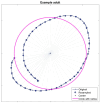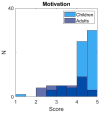A Circle-Drawing Task for Studying Reward-Based Motor Learning in Children and Adults
- PMID: 39594355
- PMCID: PMC11591306
- DOI: 10.3390/bs14111055
A Circle-Drawing Task for Studying Reward-Based Motor Learning in Children and Adults
Abstract
Childhood is an obvious period for motor learning, since children's musculoskeletal and nervous systems are still in development. Adults adapt movements based on reward feedback about success and failure, but it is less established whether school-age children also exhibit such reward-based motor learning. We designed a new 'circle-drawing' task suitable for assessing reward-based motor learning in both children (7-17 years old) and adults (18-65 years old). Participants drew circles with their unseen hand on a tablet. They received binary reward feedback after each attempt based on the proximity of the average radius of their drawing to a target radius set as double the radius of their baseline drawings. We rewarded about 50% of the trials based on a performance-dependent reward criterion. Both children (10.1 ± 2.5 (mean ± SD) years old) and adults (37.6 ± 10.2 years old) increased the radius of their drawings in the direction of the target radius. We observed no difference in learning between children and adults. Moreover, both groups changed the radius, less following reward than following reward absence, which is a sign of reward-based motor learning. We conclude that school-age children, like adults, exhibit reward-based motor learning.
Keywords: adaptation; development; motor learning; reward.
Conflict of interest statement
The authors declare no conflicts of interest.
Figures






References
-
- Fischer K.W., Goswami U., Geake J., Task Force on the Future of Educational Neuroscience The future of educational neuroscience. Mind Brain Educ. 2010;4:68–80. doi: 10.1111/j.1751-228X.2010.01086.x. - DOI
-
- Beik M., Fazeli D. The effect of learner-adapted practice schedule and task similarity on motivation and motor learning in older adults. Psychol. Sport Exerc. 2021;54:101911. doi: 10.1016/j.psychsport.2021.101911. - DOI
-
- Kluft N., Smeets J.B., van der Kooij K. Dosed failure increases older adults’ motivation for an exergame. J. Aging Phys. Act. 2024;1:1–10. - PubMed
Grants and funding
LinkOut - more resources
Full Text Sources

